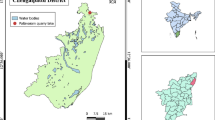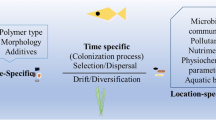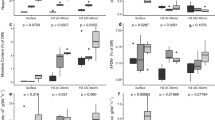Abstract
Genetically engineeredErwinia carotovora persisted significantly longer in thermally perturbed microcosms (35 days) than in nonstressed microcosms (5 days). Decreased pressure of competitors and predators and increased nutrient availability were examined as the most probable reasons for greater vulnerability of perturbed microcosms to colonization by genetically engineered microorganisms (GEMs). Indigenous bacteria that competed with GEMs for the same nutrient sources (protein, cellulose, pectate) were present immediately after perturbation in densities one to two orders of magnitude lower than in unperturbed microcosms, but their populations increased to densities significantly higher than in unperturbed microscosms 10 to 15 days after inoculation. Predators of bacteria (protozoans, cladocerans, nematodes, and rotifers) were present during the experiment in unperturbed microcosms, while dense populations of bacteriovorous nanoflagellates developed in perturbed microcosms. Preemptive inoculation of perturbed microcosms with GEMs did not have a longlasting effect on the recovery of total, proteolytic, cellulolytic, and pectolytic bacteria in perturbed microscosms, indicating the absence of competitive exclusion.
Similar content being viewed by others
References
Alexander M (1981) Why microbial predators do not eliminate their prey and hosts. Annu Rev Microbiol 35: 113–133
Amy PS, Hiatt HD (1989) Survial and detection of bacteria in an aquatic environment. Appl Environ Microbiol 55: 788–793
American Public Health Association, American Water Works Association, Water Pollution Control Federation (1985) Biological examination of water. In: Franson MAH (ed) Standard methods for the examination of water and wastewater, American Public Health Association, Washington, DC, pp 1041–1215
Bloem J, Albert C, Bar-Gillissen MB, Berman T, Cappenberg T (1989) Nutrient cycling through phytoplankton, bacteria, and protozoa, in selectively filtered Lake Vechten water. J Plankton Res 11: 119–131
Brock T (1985) Procaryotic population ecology. In: Halvorson HO, Pramer D, Rogul M (eds) Engineered organisms in the environment: Scientific issues. American Society for Microbiology, Washington, DC, pp 177–179
Brown JH, Gibson AC (1983) Biogeography, C. V., Mosby, St. Louis, MO
Cairns J Jr, Pratt JR (1986) Factors affecting the acceptance and rejection of genetically altered microorganisms by established natural aquatic communities. In: Poston TM, Purdy R (eds) Aquatic toxicology and environmental fate: Ninth symposium, ASTM STP 921. American Society for Testing and Materials. Philadelphia, PA, pp 207–221
Chao WL, Ding RJ, Chen RS (1988) Survival ofYersinia entorolytica in the environment. Can J Microbiol 37: 753–756
Cuppels D, Kelman A (1974) Evaluation of selective media for isolation of soft-rot bacteria from soil and plant tissue. Phytopathology 64: 468–475
de Boer HS (1982) Survival of phytopathogenic bacteria in soil. In: Mount MS, Lacy GH (eds) Phythopathogenic prokaryotes vol. 1., Academic Press, New York, pp 88–108
Fiksel JR, Covello VT (1986) The suitability and applicability of risk assessment methods for environmental application in biotechnology. In: Fiksel JR, Covello VT (eds) Biotechnology risk assessment: Issues and methods for environmental introductions. Pergamon Press, New York, pp 1–34
Harrison MD, Franc GD, Maddox DA, Michaud JE, McCarter Zorner NJ (1987) Presence ofErwinia carotovora in surface water in North America. J Appl Bacteriol 62: 565–570
Kotoujansky A (1987) Molecular genetics of pathogenesis by soft-rot erwinias. Ann Rev Phytopathol 25: 405–430
Lacy GH, Lambe RC, Berg CM (1981) Iris soft rot caused byErwinia chrysanthemi, associated with overhead irrigation and its control by chlorination. International Plant Propagators' Society Combined Proceedings for 1981 31: 624–634
Liang LN, Sinclair JL, Mallory LM, Alexander M (1982) Fate in model ecosystems of microbial species of potential use in genetic engineering. Appl Environ Microbiol 44: 708–714
Lindow SE (1987) Competitive exclusion of epiphytic bacteria by ice-Pseudomonas syringae mutants. Appl Environ Microbiol 53: 2520–2527
Niederlehner BR, Cairns J Jr (1990) Effects of ammonia on periphytic communities. Environ Poll 66:
Owens TG, King FD (1975) The activity measurement of respiratory electron-transport-system activity in marine zooplankton. Marine Biol 30: 27–36
Perombelon MCM, Kelman A (1980) Ecology of the soft rot erwinias. Annu Rev Phytopathol 18: 361–387
Roberts DP, Berman PM, Allen C, Stromberg VK, Mount MS (1986)Erwinia carotovora: Molecular cloning of a 3.4 kilobase DNA fragment mediating production of pectate lyases. Can J Plant Pathol 8: 17–27
Rodina AG (1965) In: Colwell R, Zambruski MS (eds) Methody vodnoi microbiologii (Translated 1972 as Methods in aquatic microbiology), University Park Press, Baltimore, MD
Scanferlato VS, Orvos DR, Cairns J Jr, Lacy GH (1989) Genetically-engineeredErwinia carotovora in aquatic microcosms: Survival and effects on functional groups of indigenous bacteria. Appl Environ Microbiol 55: 1477–1482
Scanferlato VS, Orvos DR, Lacy GH, Cairns J Jr (1990) Enumerating low densities of genetically engineeredErwinia carotovora in soil. Let Appl Microbiol 10: 55–59
Sharples FE (1983) Spread of organisms with novel genotypes: Thoughts from an ecological perspective. Recomb DNA Tech Bull 6: 43–56
Simberloff D (1985) Predicting ecological effects of novel organisms: Evidence from higher organisms. In: Halvorson HO, Pramer D, Rogul M (eds) Engineered organisms in the environment: Scientific issues, American Society for Microbiology, Washington, DC, pp 152–161
Sokal RR, Rohlf FJ (1981) Biometry, W. H. Freeman and Company, New York, pp 179–270
Stacey G (1985) TheRhizobium experience. In: Halvorson HO, Pramer D, Rogul M (eds) Engineered organisms in the environment: Scientific issues. American Society for Microbiology, Washington, DC, pp 109–121
Stanghellini ME (1982) Soft-rotting bacteria in rhizosphere. In: Mount MS, Lacy GH (eds) Phythopathogenic prokaryotes vol. 1., Academic Press, New York, pp 249–261
Strauss HS, Hattis D, Page G, Harrison K, Vogel S, Caldarf C (1984) Genetically-engineered microorganisms: II. Survival, multiplication and genetic transfer, Recomb DNA Tech Bull 9: 69–88
Trevors JT, Mayfield CI, Inniss WE (1982) Measurement of electron transport system (ETS) activity in soil. Microb Ecol 8: 163–168
Author information
Authors and Affiliations
Rights and permissions
About this article
Cite this article
Scanferlato, V.S., Lacy, G.H. & Cairns, J. Persistence of genetically engineeredErwinia carotovora in perturbed and unperturbed aquatic microcosms and effect on recovery of indigenous bacteria. Microb Ecol 20, 11–20 (1990). https://doi.org/10.1007/BF02543863
Received:
Revised:
Issue Date:
DOI: https://doi.org/10.1007/BF02543863




